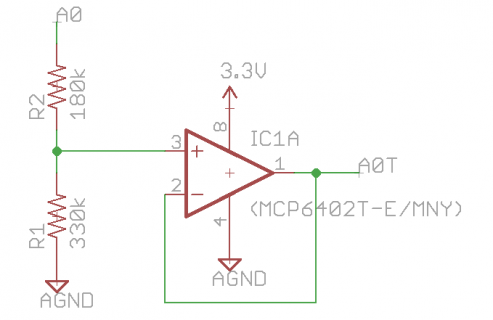Hey everybody!
I did a search about reading battery voltages over 3.3v using the ADC input on the Teensy 3.1 and I have a good idea of how others are doing this but I want to get some feedback on my specific application since the voltage is a tad bit higher than others are trying to measure.
I'm building a line of products that have solar charge controllers built into them and I want to measure the solar panel input voltage and I will also measure the solar input current via a separate current measurement chip.
The maximum input voltage is 50v DC.
Based on what I have read I think its best to supply the Teensy 3.1 from a regulated 3.3v power regulator that will be powered from a 12v battery. So the Teensy will have a rock solid 3.3v power supply.
I know I can use a simple resistor divider to knock down the solar input voltage to not go above Teensy's 3.3v max ADC input range.
Can anybody provide advice on how to get the maximum ADC resolution from a 50v input thats knocked down to 3.3v via a resistor divider setup?
Here is what SparkFun says about the Teensy 3.1 ADC resolution: 21 High Resolution Analog Inputs (13 bits usable, 16 bit hardware)
I'm not sure what the max resolution is for the ADC Analog inputs. I saw a guy using 12 bits on the forum so I know it will at least do that, but does it go higher?
I assume doing alittle sampling and displaying the median value wouldn't hurt also but this is all new to me so I'm looking for what ever advice I can get before attempting this.
Any and all help is greatly appreciated.
I did a search about reading battery voltages over 3.3v using the ADC input on the Teensy 3.1 and I have a good idea of how others are doing this but I want to get some feedback on my specific application since the voltage is a tad bit higher than others are trying to measure.
I'm building a line of products that have solar charge controllers built into them and I want to measure the solar panel input voltage and I will also measure the solar input current via a separate current measurement chip.
The maximum input voltage is 50v DC.
Based on what I have read I think its best to supply the Teensy 3.1 from a regulated 3.3v power regulator that will be powered from a 12v battery. So the Teensy will have a rock solid 3.3v power supply.
I know I can use a simple resistor divider to knock down the solar input voltage to not go above Teensy's 3.3v max ADC input range.
Can anybody provide advice on how to get the maximum ADC resolution from a 50v input thats knocked down to 3.3v via a resistor divider setup?
Here is what SparkFun says about the Teensy 3.1 ADC resolution: 21 High Resolution Analog Inputs (13 bits usable, 16 bit hardware)
I'm not sure what the max resolution is for the ADC Analog inputs. I saw a guy using 12 bits on the forum so I know it will at least do that, but does it go higher?
I assume doing alittle sampling and displaying the median value wouldn't hurt also but this is all new to me so I'm looking for what ever advice I can get before attempting this.
Any and all help is greatly appreciated.


